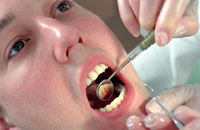How to stop tooth enamel erosion

If you consume foods and beverages with high acid levels, you increase the risk of eroding your tooth enamel. From oranges to wine, high acid intake can wear away your teeth, causing decay, sensitivity and discoloring. But that doesn’t mean you have to exclude all acidic foods and drinks from your diet. How you consume these items can lessen their damage to your teeth.
What is tooth enamel erosion?
A tooth is constructed of the crown (white part above the gumline) and the root (below the gumline). It also contains four tissues — enamel, dentin, pulp and cementum. When the enamel, or hard surface protecting the crown, wears away, it exposes the softer supportive issue, the dentin. This leaves your tooth vulnerable to plaque and bacteria, which cause decay.
What causes tooth enamel erosion?
Calcium is a key ingredient in building strong teeth. However, consuming high-acidity foods and beverages can leach calcium from your enamel, causing it to break down. Acid can come from many sources, including the following:

- Wine. Whether you choose red, white or rosé, drinking wine will soften your enamel.
- Fruit juice. Highly acidic juices include lemon, lime, cranberry, orange and apple.
- Citric fruits. Snacking on oranges, lemons and limes can wear down your teeth.
- Candy. All sweets can harm your teeth, but you should especially avoid sour gummies and candies.
- Sugar. Sugar can increase acid-creating bacteria in your mouth.
- Stomach acid. Vomiting and reflux can cause serious tooth damage when stomach acid comes into contact with your teeth. If you suffer from an eating disorder, acid reflux or a related condition, seek professional help.
What are the six signs of tooth enamel erosion?
Be aware of six early signs of tooth enamel erosion before more severe damage occurs, such as cracks, pain and decay.
- Sensitivity. As your teeth’s protective enamel wears away, you may feel a twinge of pain when you consume hot, cold or sweet foods and drinks. As more enamel is worn away, teeth become increasingly sensitive.
- Discoloration. Your white teeth can turn increasingly yellow as the thinning enamel layer exposes the underlying dentin.
- Rounded teeth. Your teeth may have a rounded or “sand-blasted” look.
- Transparency. Your front teeth may look slightly translucent near the edges.
- Cracks. Small cracks and roughness may appear at the edges of your teeth.
- Cupping. Small dents may appear on the chewing surface of your teeth, and fillings may appear to be rising from the tooth.
What can I do to protect tooth enamel?
Follow these tips to reduce the effects of acid on your tooth enamel:
- Eat acidic foods with meals. Instead of snacking throughout the day, save acidic foods for mealtimes. This will reduce their contact with your teeth and allow other foods to help neutralize them.
- Wash down food and drinks with water. Sip water alongside or after the acidic food or drink to wash it out of your mouth.
- Use a straw. If you drink acidic beverages, reduce tooth contact by using a straw and finishing the drink quickly, instead of sipping it for a long time.
- Try low or no-sugar drinks. Read nutrition labels to cut down your sugar consumption and consider switching to water, tea and coconut water.
- Wait before brushing. Since acid softens your tooth enamel, brushing immediately after eating or drinking high-acid foods or drinks can cause damage. Wait at least half an hour before you brush. In the meantime, you can rinse your mouth with tap water.
Last updated July 21, 2021
Related articles:
The oral health information on this website is intended for educational purposes only. Always consult a licensed dentist or other qualified health care professional for any questions concerning your oral health.


